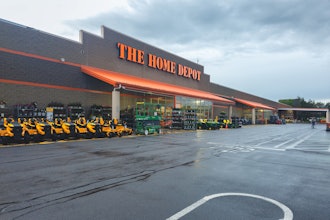Manufacturing and distribution facilities in particular have found wood waste disposal to be a costly, labor intensive problem.
Old pallets, broken crates, and scrap lumber have a way of accumulating. Manufacturing and distribution facilities in particular have found wood waste disposal to be a costly, labor intensive problem. “We used to have some issues with extra wood in our facility,” says Thomas Zelahy, Facilities Manager of the Alstom Grid plant in Charleroi, PA. “At times it was clogging up our yard and parking area, and could get in the way of some operations inside the plant. We had forklifts making multiple trips a day loading scrap wood from the unpacking area into 30 cu. yd. open top containers parked on a service road above the yard. Even so, it was difficult to stay ahead of the pallets and crates arriving every day from our suppliers.”
Hauling Fees Add Up
Transporting wood waste is a big-volume, low-weight proposition. A 40-yard container holds only one to two tons of unprocessed wood, about a quarter of its maximum capacity. In other words, up to 75 percent of the load is air. To trucking companies, a load is a load, and the more pickups the better. To their customers, however, especially high-volume generators like an auto glass distribution facility in Columbus, OH, hauling costs are a heavy burden. Ted Wenger, the facility’s Operations Manager, gives the details. “We would fill a 53-ft. semi-trailer with about a ton and a half of big open crates. We were loading five trailers a day which took up a lot of valuable dock space. They were pulled every day, and at $100 per load, our costs were going through the roof.”
Unproductive Labor
Wood waste means extra work. Someone has to move it, stack it, and load it. It’s often a full-time job for employees who would otherwise be working more productively. Take the case of TRACO in Cranberry Township, PA, the nation’s largest manufacturer of custom aluminum windows and doors. Tons of glass in large crates are delivered every day and the yard was always full of wood. “We actually had a man out there with a chain saw cutting up big crates to fit in 40-yard open top containers,” says facilities supervisor Dave McCarl. “This was hazardous work, particularly since some of the crates contained bits of broken glass. When the worker was needed inside, the wood just kept piling up outside.” Laura Beatty, Manufacturing Engineer at Mitsubishi Electric in Warrendale, PA, recalls a similar situation. “Workers were outside every day, loading scrap wood into 40-yard open tops, filling two of them per day. We were wasting manpower, so we had to look at changing this procedure.”
The Solution
Each of these companies eliminated yard clutter and cut labor and hauling costs by investing in an electro-mechanical auger compactor from Komar Industries, Groveport, OH. The auger shreds wood waste into small pieces, compacting the material and feeding 7 to 8 tons into a closed 40-yard container. The compactor is a high-torque, low RPM machine using a large pitched toothed compression screw that moves continuously forward to keep pace with constant feeding. It can safely process pallets and crates containing nails, brackets, and other tramp metals that would seriously damage conventional shear shredders.
Positive Results
At Alstom Grid, both the yard and the plant floor are now virtually empty of wood waste. The auger completely fills two 40-yard containers per week, whereas before two open top containers had to be hauled away each day. Thomas Zelahy says, “We’ve saved a huge amount of storage and work space, some labor, and a lot of wear and tear on our forklifts. We’re even saving energy. Before, in the winter time, the overhead door had to be open much of the time as forklifts with scrap wood were running in and out of the building most of the day. After the auger, the door is now closed most of the time and a lot more of the heat stays inside.”
Ted Wenger in Columbus cut his hauling costs significantly. “We went from five big trailer pulls per day to a single pull per day of a fully-packed 40-yard container. The auger reduced our labor costs and really cleaned up our dock area.” TRACO was able to return the chain saw worker to safer, more productive plant work, reducing their Workers’ Compensation exposure. Dave McCarl reports other benefits after the auger was installed. “Our yard is clean, the open tops are gone, and we’re spending a lot less on waste hauling. We went from 10 two-ton loads of wood per week to three eight to nine ton container loads per week. And that included all the plant trash and corrugated that used to go through a ram compactor.”
Mitsubishi’s Laura Beatty describes a noticeable difference with the auger. “Our unit has a customized hopper so we can load it both from inside the plant and outside. The machine works fast so we save on labor, and weekly pickups have dropped from 10 open tops to three closed containers. And it’s satisfying to know we’re not generating waste. The shredding action of the auger is actually creating the first stage of mulch.” Komar and other manufacturers also offer single-shaft pallet grinders, but Komar contends that the auger is preferable for several reasons. Grinders have a bottom discharge which involves secondary handling of the shredded wood. Tramp metals heavier than nails or staples can damage the rotary cutters. The auger can shred pieces as large as railroad ties and telephone poles, which is beyond the capability of a pallet grinder. Finally, the auger is generally less expensive to purchase and maintain.


















